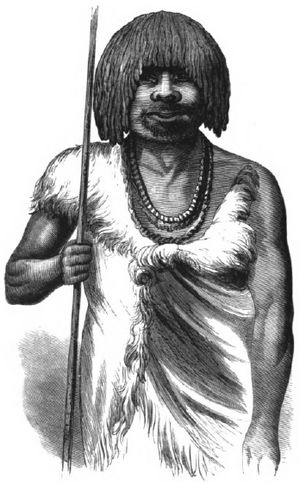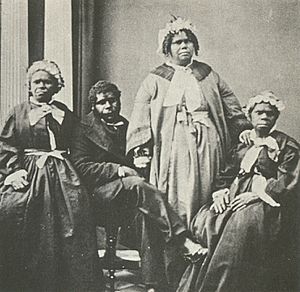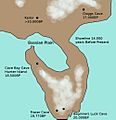Aboriginal Tasmanians facts for kids
| Palawa / Pakana / Parlevar | |
|---|---|

Illustration from "The Last of the Tasmanians" – Wooreddy, Truganini's husband
|
|
| Regions with significant populations | |
| Tasmania | 6,000–23,572 |
| Languages | |
| English (Australian English, Australian Aboriginal English) Palawa kani; formerly Tasmanian languages | |
| Religion | |
| Christianity; formerly Aboriginal Tasmanian religion | |
| Related ethnic groups | |
| Aboriginal Australians | |

The Aboriginal Tasmanians (Palawa kani: Palawa or Pakana) are the first people of the Australian island of Tasmania. Tasmania is located south of the Australian mainland. For a long time in the 20th century, many people wrongly believed that the Tasmanian Aboriginal people had completely disappeared.
Today, many people identify as being of Tasmanian Aboriginal descent. In 2016, estimates for their population ranged from 6,000 to over 23,000 people.
Contents
Ancient History of the Palawa People
The ancestors of the Aboriginal Tasmanians arrived in Tasmania about 40,000 years ago. At that time, Tasmania was connected to mainland Australia. Rising sea levels around 6000 BC cut them off from the mainland. This meant they were isolated from the rest of the world for about 8,000 years.
European Arrival and Its Impact
Before the British colonisation of Tasmania in 1803, there were an estimated 3,000 to 15,000 Palawa people. After Europeans arrived, the Palawa population dropped sharply. By 1835, only about 400 Aboriginal Tasmanians remained. This big population decline was mainly due to new diseases brought by Europeans. There were also conflicts and violence.
Efforts to Relocate the Palawa
In 1833, a man named George Augustus Robinson tried to gather the remaining Aboriginal Tasmanians. He was supported by the Lieutenant-Governor George Arthur. Robinson promised the roughly 200 survivors protection and that their lands would be returned.
However, these promises were not kept. Robinson and Lieutenant-Governor Arthur planned to move the Aboriginal people to the Furneaux Islands. This was to remove them from mainland Tasmania.
Life on Flinders Island and Oyster Cove
The survivors were moved to the Wybalenna Aboriginal Establishment on Flinders Island. Unfortunately, diseases continued to spread there, and their numbers kept falling. In 1847, the last 47 people living at Wybalenna were moved again. They went to Oyster Cove, which is south of Hobart.
Two important individuals, Truganini (1812–1876) and Fanny Cochrane Smith (1834–1905), are often remembered. They are considered to be among the last people of solely Tasmanian Aboriginal descent.
Language and Culture Today
The original Aboriginal Tasmanian languages have been lost over time. However, some words from these languages were still used by Palawa people in the Furneaux Islands. Today, there are efforts to reconstruct a language called Palawa kani. This is done by using old word lists and records.
Many thousands of people living in Tasmania today identify as Aboriginal Tasmanians. This is because many Palawa women had children with European men in the Furneaux Islands and on mainland Tasmania. Their descendants continue the rich cultural heritage of the Palawa people.
Images for kids
-
Horace Watson recording the songs of Fanny Cochrane Smith, who was considered the last fluent speaker of a Tasmanian language, in 1903.
See also
 In Spanish: Aborígenes de Tasmania para niños
In Spanish: Aborígenes de Tasmania para niños







